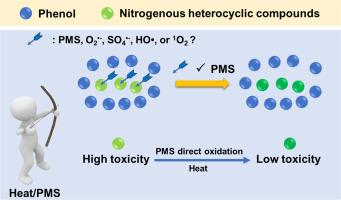在富含苯酚的废水中通过加热/过氧单硫酸盐选择性氧化含氮杂环化合物
IF 11.4
1区 环境科学与生态学
Q1 ENGINEERING, ENVIRONMENTAL
引用次数: 0
摘要
在富含苯酚的废水(如焦化废水)中,由于苯酚对各种活性氧的高反应性,很难选择性地氧化生物降解性比苯酚低、毒性比苯酚高的污染物。作为焦化废水中此类污染物的一种,一些含氮杂环化合物(NHCs)比苯酚更难被 SO4- 或 HO- 氧化去除,但本研究发现,在 10 mM 苯酚存在的热条件下,过一硫酸盐(PMS)直接氧化可以选择性地去除 NHCs(喹啉、异喹啉和吡啶)。NHCs 的选择性氧化需要一个合适的 pH 值范围(4 < 恒定 pH < 9),因为 NHCs 的质子化状态(pH < 4)不利于其氧化,而高 pH 值会提高苯酚对 PMS 的额外消耗。在加热/PMS 系统中有利于去除 NHC 的条件下,不会产生 SO4-- 和 HO-。经 60 °C/PMS 处理 60 分钟后,实际焦化废水(RCW)的生物降解性(BOD5/COD)从 0.21 提高到 0.44,但酚的去除率较低(约 10%)。喹啉和吲哚是所研究 RCW 中两种典型的 NHC,其去除率分别高达 45% 和 85%。因此,热/PMS 预处理是选择性去除富酚废水中高毒性污染物的潜在好方法。本文章由计算机程序翻译,如有差异,请以英文原文为准。

Selective oxidation of nitrogenous heterocyclic compounds by heat/peroxymonosulfate in phenol-rich wastewater
In phenol-rich wastewater, such as coking wastewater, due to the high reactivity of phenol to various reactive oxygen species, it is difficult to selectively oxidize pollutants having lower biodegradability and higher toxicity than phenol. As one kind of such pollutants in coking wastewater, some nitrogenous heterocyclic compounds (NHCs) are more difficult to be removed by SO4•- or HO• than phenol, but this study found that NHCs (quinoline, isoquinoline, and pyridine) can be selectively removed by peroxymonosulfate (PMS) direct oxidation in the presence of 10 mM phenol under thermal condition. The selective oxidation of NHCs needs a suitable pH range (4 < constant pH < 9) because protonated state of NHCs (pH < 4) is unfavorable to their oxidation and high pH would improve the extra PMS consumption by phenol. Under the conditions benefiting the removal of NHCs in heat/PMS system, there was no generation of SO4•- and HO•. Being treated by 60 °C/PMS for 60 min, the biodegradability (BOD5/COD) of real coking wastewater (RCW) was improved from 0.21 to 0.44 with low removal rate of phenols (about 10%). Quinoline and indole, as the two typical NHCs in the studied RCW, their removal rates can be up to 45% and 85%, respectively. Thus, heat/PMS pretreatment is a potential good way to selectively remove high toxic pollutants in phenol-rich wastewater.
求助全文
通过发布文献求助,成功后即可免费获取论文全文。
去求助
来源期刊

Water Research
环境科学-工程:环境
CiteScore
20.80
自引率
9.40%
发文量
1307
审稿时长
38 days
期刊介绍:
Water Research, along with its open access companion journal Water Research X, serves as a platform for publishing original research papers covering various aspects of the science and technology related to the anthropogenic water cycle, water quality, and its management worldwide. The audience targeted by the journal comprises biologists, chemical engineers, chemists, civil engineers, environmental engineers, limnologists, and microbiologists. The scope of the journal include:
•Treatment processes for water and wastewaters (municipal, agricultural, industrial, and on-site treatment), including resource recovery and residuals management;
•Urban hydrology including sewer systems, stormwater management, and green infrastructure;
•Drinking water treatment and distribution;
•Potable and non-potable water reuse;
•Sanitation, public health, and risk assessment;
•Anaerobic digestion, solid and hazardous waste management, including source characterization and the effects and control of leachates and gaseous emissions;
•Contaminants (chemical, microbial, anthropogenic particles such as nanoparticles or microplastics) and related water quality sensing, monitoring, fate, and assessment;
•Anthropogenic impacts on inland, tidal, coastal and urban waters, focusing on surface and ground waters, and point and non-point sources of pollution;
•Environmental restoration, linked to surface water, groundwater and groundwater remediation;
•Analysis of the interfaces between sediments and water, and between water and atmosphere, focusing specifically on anthropogenic impacts;
•Mathematical modelling, systems analysis, machine learning, and beneficial use of big data related to the anthropogenic water cycle;
•Socio-economic, policy, and regulations studies.
 求助内容:
求助内容: 应助结果提醒方式:
应助结果提醒方式:


